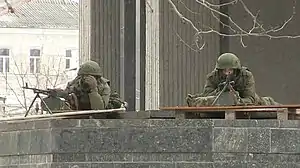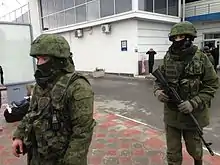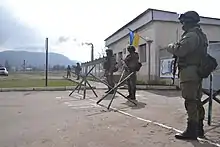Little green men (Russo-Ukrainian War)
Little green men (Russian: зелёные человечки, romanized: zelyonye chelovechki; Ukrainian: зелені чоловічки, romanized: zeleni cholovichky; Polish: zielone ludziki) are masked soldiers of the Russian Federation who appeared during the Russo-Ukrainian War in 2014 carrying weapons and equipment, but wearing unmarked green army uniforms.[1]



| External Media | |
|---|---|

The term first arose during the occupation of Crimea by the Russian Federation, a period from late February to March 2014, when such forces occupied and blockaded the Simferopol International Airport,[2] most military bases in Crimea,[3] and the parliament in Simferopol. The term has also sometimes been used to refer to Russian troops during the war in Donbas; the Kremlin denied its official involvement or the presence of its troops in the region, and they wore unmarked uniforms or disguised themselves as pro-Russian separatists.[4][5]
Russian media referred to them with the euphemism "polite people" (Russian: вежливые люди, romanized: vezhlivye lyudi)[6][7] due to their well-mannered behavior, as they kept to themselves and mostly made no effort to interfere with civilian life.[8]
The Russian Federation initially denied that these were Russian military forces, but on 17 April 2014 Russian President Vladimir Putin finally confirmed the presence of the Russian military.[9][10] Furthermore, numerous sources, including Russian state media, have confirmed that the "little green men" were a mix of operatives from the Special Operations Forces and various other Spetsnaz GRU units. It likely also included paratroopers of the 45th Guards Spetsnaz Brigade of the VDV,[11][12][13] and Wagner Group military contractors.[14][15] While their status as troops acting under the orders of the Russian government was continually denied, their nationality was not. Alexander Borodai, Prime Minister of the self-declared Donetsk People's Republic, stated that 50,000 Russian citizens fought in the Donbas up to August 2015, and argued that they should receive the same benefits as Russia's other war veterans (while still proclaiming that the government did not send them).[16]
Weapons and equipment analysis
In March 2014, the Finnish magazine Suomen Sotilas (Soldier of Finland) published an analysis of the weapons and equipment seen on photos of "little green men".
The article points to a number of weapons and pieces of equipment that it asserts are issued only to armed forces in the Russian Federation:
- New EMR camouflage combat uniforms
- New 6Sh112 or 6Sh117 tactical vest
- New 6B27, 6B7-1M composite helmet
- New 7.62 mm PKP machine guns
- 6B26 composite helmets (used only by airborne troops of the Russian Federation)
- 6Sh92-5 tactical vest (used only by airborne troops of the Russian Federation)
- Gorka-3 combat uniform (used only by Russian special forces and mountain troops)
- Smersh AK/VOG tactical vest (used only by Russian special forces)
The article goes on to conclude that with a very high probability "these troops are the 45th Guards Separate Reconnaissance Regiment of the VDV" based in Kubinka, Moscow.[13]
Other media have published a photo of an unmarked Russian soldier armed with a VSS Vintorez taken as proof of deployment of Russian special forces.[17]
Official Russian reaction
Initially, President of Russia Vladimir Putin stated that the men in green were not part of the Russian Armed Forces, but groups of local militia who had seized their weapons from the Ukrainian Army.[18] The SACEUR of NATO Allied Command Operations General Philip Breedlove said that these "green men" were in fact Russian troops.[19]
In March 2014, Putin continued to maintain that there was no pre-planned intervention,[20][21] but that "the heavily armed, tightly coordinated groups who took over Crimea's airports and ports at the start of the incursion – they were merely spontaneous 'self-defence groups' who may have acquired their Russian-looking uniforms from local [military] shops (voyentorg)".[22][23] According to the Ukrainian Association of Gun Owners, Ukrainian law does not allow the selling or carrying of firearms other than for hunting.[24]
On 17 April 2014, President Putin admitted publicly for the first time that Russian special forces were involved in the events of Crimea, for the purposes of protecting local people and creating conditions for a referendum.[25] [9][10][26][27] Later, he admitted that the Russian Armed Forces had blocked the Armed Forces of Ukraine in Crimea during the events.[28]
In response to the question of the presence of Russian troops in Crimea, Russian Minister of Defence Sergey Shoygu said, "Regarding the statements about use of Russian special forces in Ukrainian events, I can only say one thing – it's hard to search for a black cat in a dark room, especially if it's not there," and added cryptically that searching for the cat would be "stupid" if the cat is "intelligent, brave, and polite".[29][30]
In April 2015, retired Russian Admiral Igor Kasatonov said that the "little green men" were members of Russian Spetsnaz special forces units. According to his information, Russian troop deployment in Crimea included six helicopter landings and three landings of Ilyushin Il-76 with 500 troops.[31][32][33][34]
See also
- Russian military deception
- Military history of the Russian Federation
- NKVD special groups (1940s–1950s)
- People's Armed Forces Maritime Militia (PAFMM, a.k.a. 'Little Blue Men') of China
- Ratnik, 'future soldier' equipment for infantry
- Wagner Group, private military
- Hybrid warfare
- Black knight soldiers in medieval times who covered their insignia
References
- Schreck, Carl (26 February 2019). "From 'Not Us' To 'Why Hide It?': How Russia Denied Its Crimea Invasion, Then Admitted It". rferl.org. Radio Free Europe/Radio Liberty. Archived from the original on 30 October 2019. Retrieved 30 October 2019.
- "Ukraine crisis: 'Russians' occupy Crimea airports". BBC News. 28 February 2014. Archived from the original on 21 November 2021. Retrieved 6 April 2021.
- Shevchenko, Vitaly (11 March 2014). ""Little green men" or "Russian invaders"?". BBC News. Archived from the original on 29 December 2019. Retrieved 18 November 2015.
- "For now, a tense quiet in Ukraine's east". america.aljazeera.com. Archived from the original on 15 April 2023. Retrieved 24 April 2022.
- Buckley, Neil; Olearchyk, Roman; Jack, Andrew; Hille, Kathrin (16 April 2014). "Ukraine's 'little green men' carefully mask their identity". Financial Times. Archived from the original on 21 March 2022. Retrieved 25 April 2022.
Locals said that what exactly happened to make Novoazovsk headline news remains unclear, but military experts believe the Russian troops and military hardware may have moved north into rebel-held territory shortly after crossing the border. Some said they saw tanks and other military vehicles stationed about 10 miles outside the city, while others said they saw "green men" such as the ones who appeared in the Crimean Peninsula in late February.
- ""Вежливые люди" из бронзы появились в Симферополе". BBC News Русская служба (in Russian). 11 June 2016. Archived from the original on 24 November 2021. Retrieved 20 October 2021.
- "Russia Unveils Monument To 'Polite People' Behind Crimean Invasion". Radio Free Europe/Radio Liberty. 7 May 2015. Archived from the original on 20 October 2021. Retrieved 20 October 2021.
- Oliphant, Roland (2 March 2014). "Ukraine crisis: 'Polite people' leading the silent invasion of the Crimea". The Daily Telegraph. Archived from the original on 11 January 2022. Retrieved 18 September 2017.
- Путин: в Крыму действовали российские военные [Putin: there were Russian military operating in Crimea]. rferl.org (in Russian). Radio Free Europe/Radio Liberty. 17 April 2014. Archived from the original on 19 November 2015. Retrieved 19 November 2015.
- Lally, Kathy (17 April 2014). "Putin's remarks raise fears of future moves against Ukraine". The Washington Post. Archived from the original on 20 November 2015. Retrieved 19 November 2015.
- Synovitz, Ron (4 March 2014). "Russian Forces in Crimea: Who Are They And Where Did They Come From?". rferl.org. Radio Free Europe/Radio Liberty. Archived from the original on 16 February 2020. Retrieved 16 February 2020.
- Reeves, Shane R.; Wallace, David (2015). "The Combatant Status of the "Little Green Men" and Other Participants in the Ukraine Conflict". International Law Studies. 91: 393. Archived from the original on 14 January 2022. Retrieved 16 February 2020.
- Pulkki, Arto (3 March 2014). "Krimillä on Venäjän asevoimien ensilinjan joukkoja" [Crimea has first-line troops of the Russian armed forces]. Suomen Sotilas (in Finnish). Archived from the original on 12 May 2021. Retrieved 16 February 2020.
- "Revealed: Russia's 'Secret Syria Mercenaries'". Sky News. Archived from the original on 10 August 2016. Retrieved 23 April 2022.
- "Russian Mercenaries in Syria". Warsaw Institute. 22 April 2017. Archived from the original on 13 May 2022. Retrieved 23 April 2022.
- "Former Ukraine rebel head starts support group for Russian fighters". Yahoo News (AFP). 27 August 2015. Archived from the original on 14 November 2022. Retrieved 16 April 2021.
- Vaux, Pierre (18 May 2015). "Ukraine Presents Russian Sniper Rifle Taken From Captured Soldiers, Will Charge Them With 'Terrorism'". The Interpreter. Archived from the original on 20 April 2017. Retrieved 19 April 2017 – via Pressimus.
- "Путін: В Криму діють не війська РФ, а "загони самооборони", які забрали зброю в українців" (in Ukrainian). Espreso TV. 4 March 2014. Archived from the original on 3 March 2016. Retrieved 31 March 2014.
- Головнокомандувач НАТО у Європі вважає, що всі воєнізовані формування у Криму є армією РФ [Supreme commander of NATO in Europe believes that all paramilitary forces in Crimea are from the army of the Russian Federation] (in Ukrainian). RBK Ukraine. 12 March 2014. Archived from the original on 19 October 2017. Retrieved 9 November 2017.
- Fernández, Rodrigo (4 March 2014). "Putin no descarta una intervención si el caos se apodera de Ucrania" [Putin does not rule out intervention if chaos takes hold of Ukraine]. El País (in Spanish). Archived from the original on 19 October 2017. Retrieved 9 November 2017.
- Kaufmann, Stefan (4 March 2014). "Kommentar: Der Unberechenbare" [Commentary: The Unpredictable]. Handelsblatt (in German). Archived from the original on 19 October 2017. Retrieved 9 November 2017.
- Borger, Julian (4 March 2014). "Putin offers Ukraine olive branches delivered by Russian tanks". The Guardian. Archived from the original on 3 October 2017. Retrieved 9 November 2017.
- Avril, Pierre (4 March 2014). "Ukraine : Poutine souffle le chaud et le froid" [Ukraine: Putin blows hot and cold]. Le Figaro (in French). Archived from the original on 19 October 2017. Retrieved 9 November 2017.
- Kravchenko, Yevhehia (11 January 2012). Українська асоціація власників зброї: вільні люди носять зброю, раби – ні [Ukrainian Association of Gun Owners: free people carry weapons, slaves don't]. gurt.org.ua (in Ukrainian). GURT Resource Center. Archived from the original on 31 October 2017. Retrieved 9 November 2017.
- Ash, Lucy (29 January 2015). "How Russia outfoxes its enemies". BBC News Online. Archived from the original on 20 March 2023. Retrieved 7 April 2015.
- "Direct Line with Vladimir Putin". kremlin.ru. 17 April 2014. Archived from the original on 4 December 2017. Retrieved 19 November 2015.
- Gregory, Paul Roderick (5 May 2014). "Putin's 'Human Rights Council' Accidentally Posts Real Crimean Election Results". Forbes. Archived from the original on 28 June 2014. Retrieved 27 February 2016.
- Путин: Украинских военных в Крыму блокировали российские войска [Putin: Ukrainian militia in Crimea were blocked by Russian troops]. liga.net (in Russian). 17 November 2014. Archived from the original on 19 October 2017. Retrieved 9 November 2017.
- Skibina, Evgeniya (17 April 2014). Шойгу о 'зеленых человечках' на Украине: глупо искать черную вежливую кошку в темной комнате [Shoygu about the 'green men' in Ukraine: it's foolish to look for a black polite cat in a dark room]. Moskovskij Komsomolets (in Russian). Archived from the original on 25 April 2014. Retrieved 10 April 2015.
- "Kiev's claims over special forces 'resemble paranoia': Russia". Agence France-Presse. 17 May 2014. Archived from the original on 3 April 2015. Retrieved 21 March 2015 – via Zee News.
- Tambur, Silver, ed. (30 July 2015). "Finland shoring up Åland defenses against 'little green men'". Eesti Rahvusringhääling. Archived from the original on 8 December 2020. Retrieved 28 November 2020.
- Urbanska, Tetyana (22 February 2018). "Operation "Crimea is Ours"". Ukrainian Independent Information Agency. Archived from the original on 30 November 2021. Retrieved 28 November 2020.
- Owuor Otieno, Mark (8 February 2018). "Who Were the Little Green Men?". WorldAtlas. Archived from the original on 7 December 2020. Retrieved 28 November 2020.
- "Российский адмирал объяснил, почему операцию "зеленых человечков" в Крыму прозевала разведка НАТО" [Russian admiral explained why NATO intelligence missed the "green men" operation in Crimea]. ТСН.ua (in Russian). 13 March 2015. Archived from the original on 21 December 2021. Retrieved 28 November 2020.